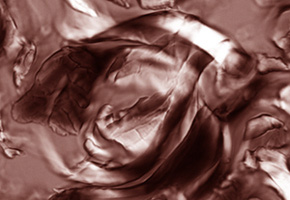

Results published in PLoS ONE journal pave the way for treatments that stimulate the metabolism of skin cells and other tissues containing collagen
Results published in PLoS ONE journal pave the way for treatments that stimulate the metabolism of skin cells and other tissues containing collagen.
Results published in PLoS ONE journal pave the way for treatments that stimulate the metabolism of skin cells and other tissues containing collagen.

Results published in PLoS ONE journal pave the way for treatments that stimulate the metabolism of skin cells and other tissues containing collagen
By Karina Toledo
Agência FAPESP – Revealing how collagen fibers in the skin and other tissues in the human body organize themselves could provide precious information for surgeons and make way for the development of new regenerative therapies. This has been one of the main objectives of Universidade Estadual de Campinas (Unicamp) Biology Institute Professor Emeritus Benedicto de Campos Vidal for nearly 50 years.
In a pioneering article published in the journal Protoplasma in 1965, he described the systematization of an optical property of collagen fibers that is typical of crystalline materials that are highly organized on a molecular level: form birefringence.
“When light passes through birefringent material, it is divided and must propagate in two different directions—each perpendicular to the other. If this object is illuminated by polarized light (whose rays propagate in a single direction like a laser), it shines,” explained Vidal.
The work was used as a comparative model in studies working to generate the second harmonic—a non-linear optical phenomenon that happens when certain materials are illuminated by a laser, resulting in the emission of a different colored light with twice the frequency of the original beam.
One of the many applications is the production of a blue laser from a red laser—technology used in devices such as Blu-ray, for example. The phenomenon has also been under study for the development of photonic quantum processors, which are much faster than the processors in use today.
Based on the capacity of collagen fibers to interact with light, the researcher developed a method to detect and measure the form birefringence of the material. The results of more recent studies conducted with FAPESP funding and carried out on the skin from rats were published in a PLoS ONE journal article.
With the use of a polarization microscope, Vidal’s team analyzed skin samples embedded in paraffin and cut into pieces 8-40 microns thick—less than half the thickness of a human hair.
“The polarization microscope has a slot where we place a compensator crystal. It has this name because it combines birefringence of the collagen bundles with its own birefringence. When they are equal, the collagen’s birefringence is canceled out, and the image of the bundles becomes dark. When the molecular structure of the fiber is in opposition to the crystal’s structures, the bundles shine,” explained Vidal.
The brilliance emitted isn’t homogenous but varies according to the direction of the collagen fiber-forming bundles. “Even within a bundle, the brilliance varies, as fibers twist to form helixes. The bundles themselves also twist, forming helixes of helixes in a structure called a helicoid,” he said.
A chamber coupled to the polarization microscope captures the image and transfers it to a computer. Through statistical variation analysis of the brilliance reproduced on the monitor, the scientists were able to study the collagen fibers’ distribution patterns. “We also measured the birefringence in nanometers through image analysis and birefringence compensation,” said Vidal.
Liquid Crystal
This method of detecting and measuring birefringence had already been proposed by Vidal in a previous report and has been used by other researchers to describe the distribution of collagen fibers in tendons. “It has also been used to produce silicon membranes with optical properties important for data transmission and use in communication,” he said.
In the most recent study, the Unicamp team showed that collagen fibers in the skin have the same non-linear optical properties as those in tendons, making way for new treatment.
“When skin is squeezed or massaged, the fibroblasts—cells that synthesize the precursors of collagen—receive topographical signals emitted by the fibers, and they react. If the distribution of the fibers in the skin is known, light (photonic effects) and a special massage could increase blood circulation and stimulate metabolism, helping skin cells to recover,” Vidal noted.
According to the researcher, this knowledge could also lead to new applications in Physics. “My theory is that collagen bundles in the skin and the tendons are not in a solid state or a liquid state, and they are, of course, not gaseous. They are actually liquid crystal and could be used to conduct light like fiber optics,” he stated.
The article “Skin Collagen Fiber Molecular Order: A Pattern of Distributional Fiber Orientation as Assessed by Optical Anisotropy and Image Analysis” by Juliana Fulan Ribeiro and others can be read at: www.plosone.org/article/info:doi/10.1371/journal.pone.0054724.
Republish
The Agency FAPESP licenses news via Creative Commons (CC-BY-NC-ND) so that they can be republished free of charge and in a simple way by other digital or printed vehicles. Agência FAPESP must be credited as the source of the content being republished and the name of the reporter (if any) must be attributed. Using the HMTL button below allows compliance with these rules, detailed in Digital Republishing Policy FAPESP.




